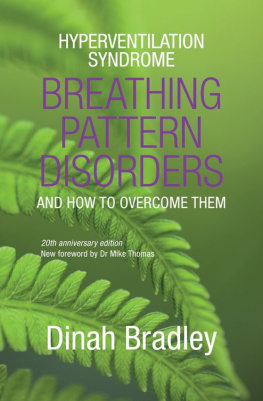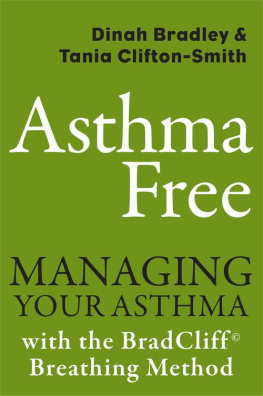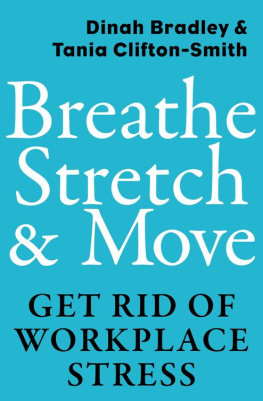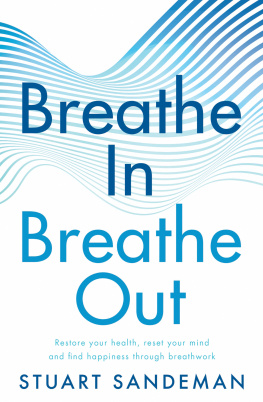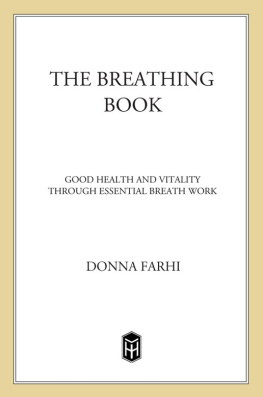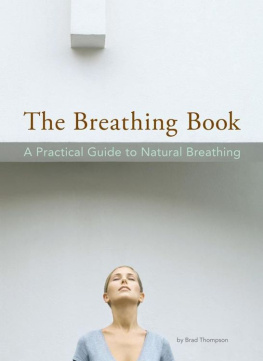If so, you are not alone. Twelve per cent of the population suffers from hyperventilation syndrome in varying degrees, and experiences distressing fears along with the puzzling array of symptoms that accompany bad breathing.
This fully revised edition contains a workbook section to help the reader identify how their stress levels, sleep and symptom patterns interrelate with each other. Also included are a number of personal stories from people who have been identified as chronic hyperventilators and who have overcome their problems by using the drug-free methods outlined in this marvellous and important book, which has been continuously in print for 20 years.
DINAH BRADLEY IS A QUALIFIED PHYSIOTHERAPIST WHO HAS BEEN INVOLVED IN MANY AREAS OF HEALTH CARE. SHE IS RECOGNISED BY MEDICAL PRACTITIONERS AROUND THE WORLD AS AN EXPERT SPOKESPERSON ON HYPERVENTILATION AND RUNS HER OWN BREATHING CLINIC.
I t is with great pleasure that I write the foreword to a new edition of this excellent book, which has been of great interest and practical use to many people (including many doctors and other health professionals) for a number of years. The need for an accurate and reliable source of information and instruction in this area is as great in 2011 as it was 20 years ago, when the book first appeared.
It is probably true that there is a greater recognition of the various health problems that can be associated with abnormal breathing now than then, both among medical professionals and in the general public. Recent years have seen an expansion in scholarly articles and research in this field, with more rigorous scientific research underpinning the principles presented here. There is also more interest from the general media in the recognition and treatment of the overlapping problems of hyperventilation, dysfunctional breaching syndromes and breathing pattern disorders. However, there is little doubt that many people continue to suffer from avoidable ill health and quality of life impairment because they are not breathing in a normal, healthy way.
The symptoms produced by abnormal breathing are characteristic but are not specific to breathing problems, and can cause difficulties in diagnosis and treatment. Doctors tend to be focused on excluding important causes of breathlessness, chest discomfort and fatigue, and clearly it is vital that serious illnesses such as heart disease, asthma, anaemia and blood clots in the lung need to be found and treated.
Unfortunately, when such illnesses are ruled out, other and more subtle causes of symptoms are often forgotten about, and patients may come away thinking that they have been labelled as being neurotic or imagining their (very real!) symptoms, or that there is nothing that can be done to improve the situation. I am sure that there are many people all around the world in this situation, putting up with symptoms and curtailing their life and activities because of them.
Even when suspected by the doctor or patient, there is often little availability of access to people who have expertise in treating such problems. This is a sad state of affairs, especially when the results of treatment by an appropriately skilled therapist can be so rewarding for the patient and the professional. Surveys indicate that as many as one in 10 people may have symptoms and quality of life impairment from abnormal breathing, and most wont have received a diagnosis or been offered any treatment.
I hope that this situation is slowly improving! There is certainly more awareness now that many people with asthma can improve their symptoms through education and instruction in exercises designed to restore a more normal and functional breathing pattern. However, there remains a real need for a concise and reader-friendly book to explain how abnormal breathing can occur, what the effects of it are, and what can be done about it. In an ideal world, all with this problem would have access to a suitable skilled respiratory physiotherapist in a face to face setting. Even then, it can be very helpful and reassuring to have a reliable source of information and instruction to refer to. For those finding it hard to understand their symptoms and to get help with them, such a book can be a lifeline.
Having had a clinical and research interest in this area for 20 years, one of the biggest problems that I have perceived is the lack of reliable information. We live in an information overload era, and there are many people, seemingly knowledgeable and authoritative, claiming to understand the causes of ill health and offering ways of improving it. Unfortunately, in the field of breathing training, not all the information in the public arena bears up to close scrutiny, and sometimes misleading and exaggerated claims are made for different therapies. A simple, pragmatic and accessible source of accurate information and advice is therefore invaluable. This book has provided it for many years and continues to do so.
DR MIKE THOMAS PHD FRCP
Asthma UK Senior Research Fellow, University of Aberdeen Chief Medical Advisor, Asthma UK
M y sister lent me an earlier edition of this book several years ago. I put it in my to read later pile, and thought nothing more of it. A year later two weeks before my 21st birthday I landed in hospital as the result of a nasty combination of a chest infection, anaemia, the inevitable change of season, and my long-term asthma.
When I was first diagnosed with asthma and given the sticky, sugary Ventolin syrup, I was told I would grow out of it in my teens. My doctor also said, Breathe through your nose. I tried. It was uncomfortable. I gave up. That was the only practical advice that anyone ever gave me, other than to take your medicine regularly.
Until that major attack I had tried to ignore my asthma, although, looking back, there was no way I could. I was bound to it. I would feel powerless and panicky if I found myself somewhere without my puffer, and I had no reliable method to calm myself down. Graduating to steroid preventers made it worse because now I had two inhalers to lug everywhere. And to use an inhaler in public felt like I was admitting to those around me that I was unfit and unhealthy even though I have always been a regular exerciser.
Although the hospital episode was a miserable and painful one, it was also the turning point in my attitude to my asthma. Interestingly, it wasnt being in hospital that panicked me. I was warm and well looked after, apart from the chain-smoking doctor who, without asking, trundled in with 10 medical students, tried to convince me it was psychosomatic, and let me know that asthma gets worse for women in their early twenties.
The panic came when it was time to leave. Our house was being renovated, there was sawdust everywhere and that scared me. It was a windy day outside and that scared me. The idea of dancing at my own 21st scared me. The thought of setting foot inside a smoky bar terrified me, let alone getting to the end of a sentence in my broadcasting job. In short, in the hospital the medical staff and oxygen masks were in control of my lungs. Outside, it was just me.
After 21 years of letting other people (not) tell me what to do, and being a slave to my inhaler, I had developed a strong sense that there must be another way for me to gain power over my asthma. And since no one was offering, I had to ask around. At the asthma clinic where Id been referred I asked if there was some sort of breathing specialist. Thats when I met Dinah Bradley.

